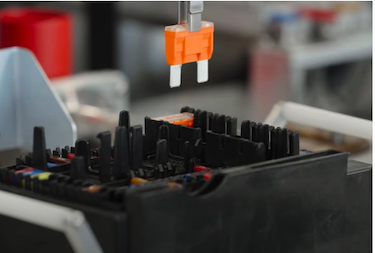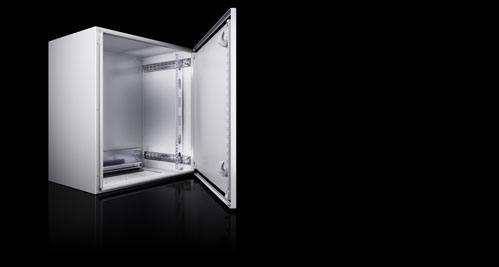by Rittal North America LLC
Enclosures are the foundation to ensuring products run smoothly. They protect your electronic controls and equipment to run vital machinery. However, it is critical to use the right enclosure for the application. Ratings, material types and finishes, and style all play an important role in maximizing the protection of all electrical components inside enclosures.
If you are using the wrong enclosure for the environment, you risk exposing the internal components to hazards from dirt, dust, and debris to chemical and liquid ingress which can cause equipment failure. Understanding the basics of enclosure selection will help in choosing the enclosure that will protect your indispensable equipment and keep operations running.
1). Ratings
The National Electrical Manufacturers Association (NEMA) and the International Electrotechnical Commission (IEC) provide a set of standards that describe the degrees of ingress protection from dirt, debris, water, chemicals, and other liquids. Enclosures that fit the ratings laid out by NEMA or IEC will need to be certified if they are to display the UL or TUV mark. Manufacturers will conduct product testing to verify that their specified ratings meet the testing requirements.
Products that meet this level will have a mark of certification from companies including UL and TÜV. Enclosures with this mark ensure that the enclosure you’re selecting will provide the required protection for the environment and application as stated in the standard. Proper protection will help ensure a long service life of the equipment and controls being housed inside.
2). Materials and finishes
The material the enclosure is constructed from can play an important role in protecting the internal components. From protecting against environmental factors like rain or chemicals used in washdown to protecting data integrating and preventing electromagnetic interference, the right material will provide added protection.
Polycarbonate is a thermoplastic and is used in applications where total weight is a concern such as in maritime use. It also resists corrosion and UV rays and offers a degree of water protection, so it is commonly used in outdoor applications including solar or wastewater treatment. As it is a non-metallic material, it naturally prevents electrical arching or shorting. Its composition further allows radio-waves to penetrate allowing for protection of equipment that requires wireless transmission.
Aluminum is a lightweight option that provides more durability than plastic. One of the main benefits of aluminum is that it allows heat to dissipate in addition to protecting against outside elements. Unlike its plastic counterpart, there is natural shielding from radio-frequency interference (RFI) making this a choice for those that need added security for the internal equipment. This material is commonly used in telecommunications, traffic control, and battery storage applications due to its resistance to weather fluctuations. Additionally, it provides protection from alcohol, solvents, oils, and more.
Carbon and Stainless Steel are frequently used in industrial applications as they both provide added protection and durability for most environments. Carbon steel is suited for most environmental conditions and have four grades based on carbon content – Low Steel, Medium Steel, High Steel, and Ultra High Steel. Stainless Steel has two composition types – 304 and 316 offering varying degrees of protection from corrosion, temperature fluctuations, and water. Its composition is fitting for oil and gas production, pharmaceutical manufacturing, food and beverage, and many other industrial facilities.
Finishes can play an important role in the total cost and aesthetics of the enclosure. If you plan to make modifications to the enclosure, you’ll want a finish that is resistant to scratches and chipping whereas a consistent and clean looking enclosure layout may be important in other areas of operations or customer interactions.
Blasting, Polishing, and Buffing will smooth out any roughness and create a polished finish. Blasting has the added benefit of completing the cleaning and finishing in one step which can reduce some of the cost. However, these options provide limited surface protection from external factors.
Wet or Powder Coating is an affordable option that creates a clean look and provide more color customization options compared to other finish choices. However, it is prone to scratching and chipping which can add costs if the panels are being modified. Any finish damage will need to be redone to provide the proper grounding protection and keep the aesthesis of the enclosure looking clean.
Zinc plating provides a grounded coating that does not chip or scratch. This ensures the integrity of the enclosure remains intact even throughout modifications. The entire surface is immersed in the zinc coating ensuring complete protection and keeping the aesthetic appeal of the finished enclosure.
3). Enclosure style
Choosing an enclosure style to fit your application specifications is crucial to creating a solution designed for your needs. Deciding on unibody, modified, or modular can be challenging; starting with your unique needs will put you on the path to success. Determining how the enclosure will be used today and what the future application needs are will help in the decision-making process.
Unibody: Heavy gauge sheet steel welded together are the defining characteristic of unibody enclosures. They can create a durable enclosure; however, fewer access point will be available. This can make it challenging for maintenance and modifications. Additionally, it limits flexibility so using this option in certain environments including maritime or earthquake prone areas, may actually diminish its integrity due to the vibrations and shock the structure will undergo.
Modified: While there is a lot of talk around modified enclosures, they only allow you to add customizations to an existing structure. Creating cutouts for controls, switches, and more is a necessity, but you are limited to how customized the complete enclosure will be.
Modular: Choosing a modular solution, presents more control over the final customization. The ability to modify all panels with the necessary cutouts or additions is still an option, but you gain the ability to create additional updates or modifications as facility and operational needs change. In a modular solution, the strength of the enclosure system is in the frame, making this a strong, durable, and flexible option. It also allows replacement of a single panel if numerous changes are needed, supports the separation of sections within the enclosure using various sized panels, or connecting enclosures together across all sides. Modular enclosures grant ultimate control over your end solution and accommodate the needs of tomorrow in a more cost-effective way than unibody.
Making an informed choice on enclosure selection will lead to a successful solution built for longevity. Along with understanding the environment and application needs of your enclosure, insight into the ratings, material types, and enclosure styles will boost your knowledge throughout the enclosure selection process. You will be able to confidently select the enclosure for your unique needs and have assurance that your choice will not only support current needs, but the requirements of tomorrow.
About Rittal North America, LLC
Rittal North America, LLC is a global manufacturer of industrial and IT enclosures, racks, and accessories, including cooling solutions and power management systems for industrial, data center, outdoor, and hybrid applications. Rittal provides innovative, high-quality solutions for practically any industrial or IT infrastructure application, from single enclosures to comprehensive, mission critical systems. Products are tested and certified to the appropriate standards that apply, including UL, CSA, ATEX, NEMA, and more. For more information, visit http://www.rittal.us. Ready to design your enclosure? Check out the Rittal Configurator Tool































































